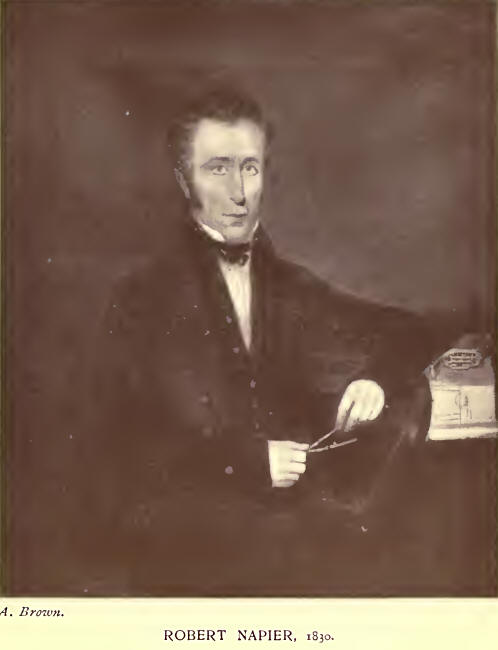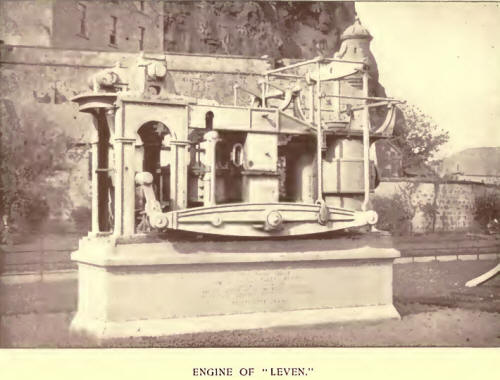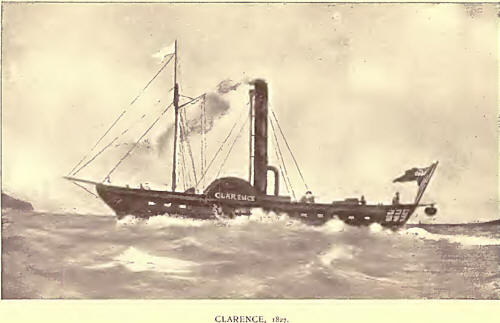|
In 1821 Robert Napier entered into a lease of his
cousin’s premises at Camlachie, and removed his dwelling-place to
White-vale. The rent of the foundry was £300 a-year, including the
use of tools; but as this sum was more than ten times what he had
been paying for his old shop, and as there was considerable risk in
the venture, he had the option of giving up the lease at the end of
the first year. Though a great advance on what he had hitherto been
working with, the plant at Camlachie was of the most modest
description. There were a few 10-inch and 12-inch lathes, a rude
horizontal boring-mill, a vertical machine, and the necessary
appliances for making castings; but even with these tools he
succeeded in turning out first-class work.
One of his first steps was to fix upon a good works
manager. In making this selection, he was most fortunate in securing
the services of Mr David Elder, who continued with him for forty
years. Mr Elder came from the east country, and was a very sterling
upright man. He was a millwright to trade, and would turn out
nothing but the most solid work, on which he put the most accurate
finish. He was nearing forty years of age when Mr Napier engaged
him, and a good deal of millwright work had previously passed
through his hands.

Established in his new premises, Napier undertook a
contract for large water-pipes for the City of Glasgow, which he
executed satisfactorily. The first order for machinery came from Mr
Boyack, of Dundee. It was for an engine of 12 H.P., to be used in
driving a mill; and so well and substantially was this made that it
was running at the date of Mr Napier’s death, fully fifty years
afterwards. Orders of a similar nature followed, and he also made
numerous land engines. Robert Napier, however, perceiving that there
was a great future in steam navigation, desired more especially to
construct marine engines like those with which his cousin David had
been so successful.
Failures were then more frequent than successes, and
as he was an untried man as a marine engineer, he had great
difficulty in attaining his wishes.
Through his Dumbarton connection he was acquainted
with the Langs, and from them he ultimately, in 1823, succeeded in
getting an order for the engine of a luggage-boat they were about to
build.
As so much hung on the satisfactory carrying out of
this contract, he bestowed on his first marine engine his best skill
and finish, introducing improvements on the condenser, air-pump,
slide-valves, &c., and taking special care to have the framework
strong and rigid. The Leven succeeded beyond his most sanguine
hopes, and her engine, after lasting out three hulls, finally found
a resting-place on a pedestal at Dumbarton Castle as a monument to
the constructor.
This order was speedily followed by others, and he
was now constantly employed as a marine engineer, constructing
machinery for river boats and larger vessels, such as the Belfast
steamers Aim-well and St Andrew, in the running of which he appears
to have been interested.

It may be noted that in the early days of steam
navigation the builder was frequently the owner of the vessel, and
it was generally owing to his initiation that new routes were
started. Thus in 1818 David Napier began the Belfast trade with his
steamer Rob Roy, and in 1826 Robert Napier made a further forward
stride in the same trade with the Eclipse, which he in great part
owned. At the time she was described as “the most complete vessel of
her size ever built on the Clyde; in point of sailing unequalled by
any vessel; built of the best British oak, copper-sheathed and
fastened, with double side-lever engines, having cylinders 35 inches
in diameter, warranted equal in construction and workmanship to the
best engines made.”
Being desirous of selling this vessel, and hearing
that some of the London companies wanted crack steamers, he went to
London in the spring of 1827, and stayed with his Inveraray cousin,
David Napier, who was then becoming known as a skilled mechanic,
especially in connection with the invention of the rotary
printing-presses, so much used in later years in the production of
the ‘ Illustrated London News’ and other papers.
Messrs Maudslay were then reckoned the most famous
engineers in London, and being desirous of seeing their works,
Napier approached them through his cousin, who had at one time been
in their employment. He received a most gratifying reply to his
request for permission to visit their premises :—
Mr Maudslay’s respectful compliments to Mr Napier,
and begs to say he always feels more gratification in meeting or
seeing any gentleman who has a knowledge of the business he is
engaged in than the thousands who go about taking up the time
without gaining any information. . . . Mr M. will therefore be glad
to see Mr N. either on the receipt of this or at 4 o’clock, or
to-morrow morning, Friday.
Lambeth, March 1, 1827.
This letter was specially complimentary, as the
London engineers did not then throw open their works readily for
inspection.
He was at this time living quietly at 31 White vale,
and there are few letters of general interest extant. There is,
however, one from his friend Dr Chalmers, who had just resigned the
charge of St John’s in Glasgow, on his appointment to the Chair of
Moral Philosophy in St Andrews University.
Kirkcaldy, November 13, 1823.
Dear Sir,—Having had no time in Glasgow, I wish to
thank you (now on my way to St Andrews) for the use that you so
kindly allowed us of a child’s coach, from which our little daughter
derived a great deal of enjoyment, and also of substantial benefit.
May I beg my most affectionate regards to Mrs Napier
and your brother.
I should have called along with Mr Sommerville upon
you for the purpose of introducing him to your acquaintance. This I
was not able to accomplish, but I hope that you will soon meet, and
that he will prove a blessing in the highest sense of the word to
your family.
It is my great wish that the chapel shall prove a
blessing to your immediate neighbourhood.
Give my compliments when you see him to your cousin,
David Napier, Esq.—I am, dear Sir, yours truly, Thomas Chalmers.
The brother Dr Chalmers referred to was the Rev.
Peter Napier, who was then assistant minister in the High Church, in
Glasgow, from which in the following year he was presented to the
church of St Georges-in-the-Fields, a charge then newly created. In
later years Dr Napier became minister of the Blackfriars, or what
was more commonly known as the College Church of Glasgow, a position
which he occupied till his death, which took place in 1865.

Robert Napier was now no longer an unknown engineer,
and his reputation as the best engineer on the Clyde was established
in 1827.
The Northern Yacht Club, at their regatta in August
of that year, offered a cup, valued at twenty guineas, for the
swiftest steam-boat. The course was from Rothesay Bay round boats
moored at the north end of the Great Cumbrae, and back to Rothesay.
Several steamers entered for the race. The contest was an exciting
one, occupying nearly three hours, but in the end victory lay with
Napier’s steamers, the Clarence winning the cup, and the Helensburgh coming
in a good second. This apparently trivial incident was one of the
most important events in his life, and had a material bearing on his
subsequent career.
Up to this point his life had been a laborious
struggle to obtain a subsistence, and his position little more than
that of an industrious master mechanic.
His success changed the situation. Orders, not only
from Glasgow but from other quarters, flowed in on him, and he began
to find himself in affluent circumstances.
He now entered into negotiations with his cousin for
the purchase of Camlachie Works which he had hitherto leased; and to
meet the growing requirements of his business he resolved to obtain
premises near the Clyde. A favourable opportunity presented itself
of acquiring the works at the foot of Washington Street, where Mr
M'Arthur had carried on business as a marine engineer, and he
availed himself of it. |

